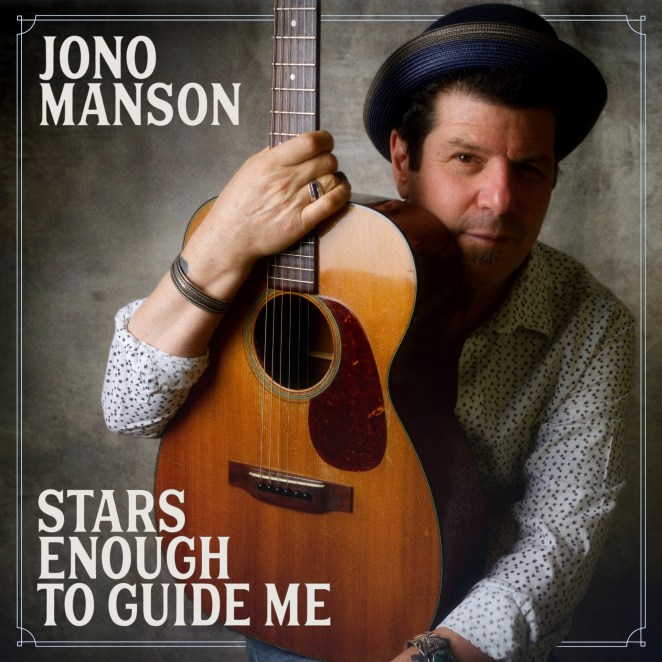When the stars align, sometimes pieces from the past resurface on the fabric of the present and future. Once he turned 60, Jono Manson found himself inadvertently reflecting on his career, one that began in his hometown of New York City in the 1970s, on through his time with Joey Miserable and The Worms in the 1980s, and later transported him to a new life in New Mexico by the ’90s, with a collection of collaborations spanning Blues Traveler, T Bone Burnett, Amanda Palmer, Ray Wylie Hubbard, and more.
Videos by American Songwriter
Working through a new collection of songs following the release of his 2020 album, Silver Moon, Manson began reconnecting with a collection of musicians that peppered his 40-year career, while working with his current, and new, collaborators on his latest release Stars Enough to Guide Me.
“Hitting my 60s has fueled a desire to bring all these different parts of my musical life together in one place,” said Manson in a statement. “Whether that meant teaming up with guys from the early days in New York again or sending off parts to Italian artists I’ve worked with or bringing New Mexico folks right here into the studio with me, all those players are a part of my journey, and I wanted this album to capture that.”
Recorded at Manson’s own The Kitchen Sink studio in Santa Fe, New Mexico, the album features Blues Traveler John Popper, American Idol alum Crystal Bowersox, and folk singer and songwriter Eliza Gilkyson, along with some friends from the past, including Kevin Trainer, Jon Graboff, and Jason Crosby.
Stars Enough to Guide Me marks a new season in Manson’s life, and reveals his mastered diversity in roots, soul, folk, and country, triggered from the opening letter of perseverance in “Lights Go Out,” and through other personal narratives with the folkier “On the Downlow,” “No New Kind of Blue,” featuring Popper, “Timberline.” On Stars, Manson also chronicles escapades of life on the road in the blues rocker “The Further Adventures of Goat Boy and The Clown,” and shares more pensive roots on “Make It Through the Spring” and the closing “Late Bloomer.”
“Now is the time, I’m singing better than I ever have,” said Manson. “I understand myself on a deeper level than ever before, and I’m in the middle of one of the most creative, productive periods I’ve ever experienced. I might be pushing 62, but it feels like I’m just getting started.”
In the middle of producing an album for the Italian band The Gang, another with Terry Allen, and new music he plans to record in New York City later in the year, Manson is also set to tour with Blues Traveler in the fall of 2023.
Manson recently spoke to American Songwriter about writing in this chapter of life, where past songs take up space now, and how all the stars aligned for his new album.
American Songwriter: After releasing Silver Moon in 2020, and everything came to a halt around the pandemic, when did the songs for Stars Enough To Guide Me start coming together?
Jono Mason: It was far from an ideal time to promote a new project, but I had already set all the wheels in motion and didn’t see any point in holding it back. At my age, I’m done waiting for a better time to make a move. The time is always now. Like the rest of my colleagues, I was forced to take a break from live performance, and so had more time to write. Some of the songs on Stars Enough To Guide Me go back to that time, but, I tend to write in batches, so the songs on this album were written in several groups over time. I also recorded the project in several sessions over the course of six months or so. I tend to spend a lot of time producing projects for other people, so I had to make a conscious effort to carve out the time, not to mention creative headspace, to make this album.
AS: As you spent more time with these songs, from writing to recording, were there some underlying links that you began to notice between the 11 tracks?
JM: Fairly often, a body of work starts to reveal an underlying subtext that I wasn’t necessarily aware of while in the midst of writing. Sometimes, I will see it during the process, and then consciously incorporate it into subsequent songs that I am working on. In the case of this body of work, I started to realize that many of the songs were more autobiographical than I had expected at the outset. So, I didn’t shy away from telling my story in a more direct manner. Songs like “Lights Go Out,” “Late Bloomer.” “The Further Adventures of Goat Boy and the Clown,” “Timberline,” and “On the Downlow” definitely fit into this category. They all contain underlying themes of perseverance in the face of adversity and looking back at life with the perspective that comes from growing older.
AS: What led to the album title Stars Enough To Guide Me?
JM: The title comes from a line in the song “Lights Go Out.” On the surface, the album title seems quite serious, but if you listen to the verse that I borrowed it from, you realize that its origins are actually pretty tongue-in-cheek. The song uses a boxing metaphor, expressing that as long as you can stand up one more time than you’ve been knocked down, you’ll always have a chance, however slim, to win. The line from the song—If you want to stand beside me, I will never let you down, I’ve seen stars enough to guide me, once I get up off the ground—what I really had in mind when I wrote that line was something like what you see when someone gets knocked down in a cartoon fight. When they stumble to their feet, little animated stars swirl around their head. In the context of the entire body of work, the title seemed fitting.

AS: Sonically, what sound were you hoping to capture for Stars during production?
JM: I wanted to go for a live sound. That is to say that I want the listener to be able to close their eyes and imagine the ensemble that is playing the music. Certain elements of the project were recorded that way with everyone playing at once, but not the whole thing. My goal was to maintain the feeling of interaction that happens when musicians are able to play off of one another, in the moment. I produced, recorded, and mixed Stars Enough to Guide Me myself. But, self-production can be a tricky thing, at least for me. I’ve gotten pretty proficient at it over the years, but it’s a major undertaking. I’ve heard it said that self-production is like “self-dentistry,” meaning that there are some things better not left in your own hands. At this year’s New Mexico Music Awards—the Mayberry Grammys, as I like to call them—I took home the Norman Petty Producers Award for my work on the album. So, at least whoever judged that category thought I did a good job.
AS: Thinking back to the songs on One Horse Town (1993) or Under the Stone (2001)—and even your days with The Worms—what’s your relationship with some of your older songs now?
JM: When I look back at much of the work I’ve done over the years. I can’t help but see many of the songs as mile markers along the way. Sometimes I revisit earlier work, and I’m surprised at how much I still like it. It takes me a while to be able to listen to past albums I’ve done, and be able to hear them from a listener’s perspective. It’s interesting that you mention those songs in particular because they are among those that I am still particularly fond of. “Under the Stone,” in particular, was one of those songs that spilled out all in one piece, and I barely had to change a word before I felt like it was ready to perform. Those songs feel like gifts whenever they come, so I think that, even though the average listener is unaware of this fact, I tend to cherish them more.
People have different theories about how this happens. Some feel that the writer is channeling something that comes through them from some other place, others subscribe to the theory that the subconscious mind is churning away, and when the song is ready it pops out. Whatever the answer, I’m happy when it happens. Back in my days with The Worms, I looked at songwriting more as a vehicle for the band to have material to keep the party going (rather than make people think or feel anything in particular) and that party did manage to continue for 10 years.
AS: Are you still the same songwriter you were when you first started?
JM: I really feel that I’ve grown quite a bit as a songwriter, especially in the last decade. I honestly feel like I’m just figuring it out. Not to say that I dislike my earlier work, but it’s a good thing to feel like you’re still growing even at this stage in the game. Also, my move from New York to New Mexico over 30 years ago definitely created a big shift in my trajectory as an artist. Put simply, I was no longer writing in the context of “bar band“ rock and roll and was being exposed to a very different set of stimuli, both musically and environmentally. For example, I’m not sure if I would have written a song like “Timberline” had I remained in New York City.
I have definitely learned that the “art” and “craft” of songwriting are two separate things, although they are far from mutually exclusive. Sometimes songs appear as if out of the ether. Other times, I’m given an assignment to write one, and these often involve two very different processes, although one always seems to inform the other. Also, through rather extensive experience performing my music in front of audiences who speak little or no English [in Italy], I’ve learned that often, more important than the actual meaning of the words themselves, is the emotion conveyed by sound of the words, through the confluence of melody and underlying harmony, and in the performance. I’ve had people who didn’t understand a word I was singing, approach me after a gig, and say that they felt “kindness“ or “sadness“ in a song. This has been a real eye-opener for me.
We spend so much time trying to hone a clever turn of a phrase, and I likely won’t stop doing that, but I am acutely aware that there is so much more that can be transmitted by a song.
Photo by William Coupon / Propeller Publicity
